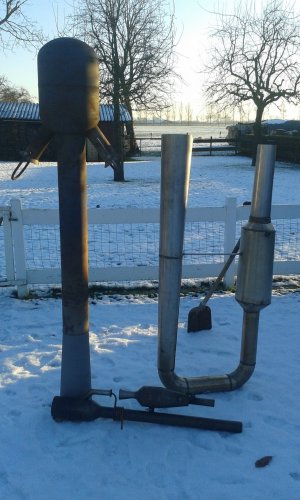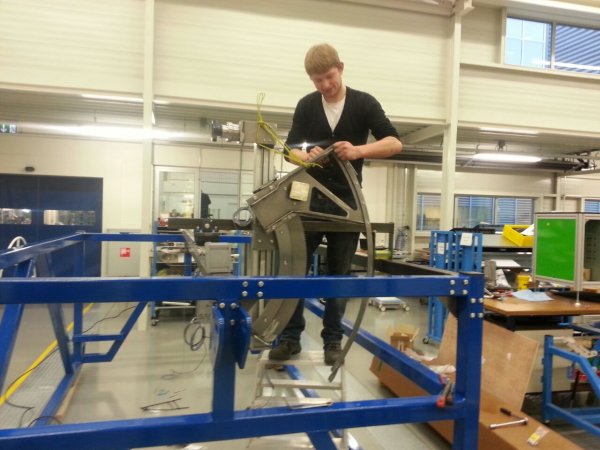Hi, my name is Jop Nijenhuis. And I’ve been asked to write a short blog about myself, as the new intern here at Copenhagen Suborbitals. Well where to start, I’m 21 years old and from the Netherlands. Being the type of student that likes a lot of engineering disciplines, resulted into me study Mechatronics Engineering. Being a combination of mechanical engineering, electrical engineering and control engineering. Which I’m studying at the Saxion University of Applied Sciences in Enschede.
As I’m writing this, I’m sitting in one of the small offices at CS. On the right wall of me a huge white board full of technical sketches and drawings surround by presumably Danish words. On the left, a poster compilation of famous rockets, fan mail, flow diagrams of the BPM-5 and preliminary flight specs. of Spica. This reminds me of how I actually first got word of CS, I was googling some info for a hobby project of mine, when I came across this picture of a concrete test stand with what I assumed to be a Rocketdyne A7. After trying to figure out the why’s and how’s, I found this YouTube video of former CS member and founder Peter Madsen, standing next to the TM65 rocket engine in his workshop. Me knowing a little bit about rockets was just intrigued about them actually having built this one of a kind machine. One thing that I’ve kept asking myself during the video, where’s the turbo pump? I’ve been following CS ever since, watching their videos over and over, and following their live streams. Being amazed by their motivation, organizational structure and ingenuity, they sure got “the right stuff”.
My graduation internship revolves around a central assignment that I got offered whilst visiting in December 2015. To design and built a TVG (thrust vectoring gimbal) for the BPM5 rocket engine. As most of you might know, the Nexø class is currently guided by jet-vanes which has proven itself in the past on Sapphire. Some drawbacks of this configuration are however, limited operation cycle due to erosion of the graphite in the exhaust stream, and the drag generated by the vanes being in the exhaust stream (lowering effective thrust levels with approx. 10%).
One major design requirement for my TVG being that the general design should be scalable for the Spica class/BPM-100, which will require a gimbal for guidance.
To sum up some of the subjects that I’m covering;
- Design of a TVG and actuator system. Which will probably be an RD170 style ring-joint (to allow for a central LOX dome entrance) with maybe a hydraulic actuator solution. Which might be a bit over-engineered for the Nexø class, but feasible for Spica.
- Redesign of the propellant valves
- Redesign of the lower engine bay, to house all the above mentioned systems.
If all goes well I’m hoping to have a functional test article somewhere end June, just before my graduation deadline.
I’ve now went inside the workshop to finish this blog, just reminding me again that CS is an actual space program. The workshop is full of rocket hardware as I walk in, both propellant tanks of the HEAT2X are inside and BPM-5 parts lay everywhere in big crates. I just love how they keep saying that the Nexø class is small, being used to building the HEAT2X and such. They sure lost their sense of scale, I find Nexø I enormous.
This might be the time to write some about my personal background, I’m quite a tinkerer and love to build things. Nothing like coming home to my parents after a week of studying and living in my dorm room, and just have the freedom to build and test things during the weekend
Space is a big part of my life, not many launches go by without me following the livestream or news updates, even my dog is called Sputnik. Something sparked inside of young-me when I first got news of the twin Martian rovers having safely landed on our second smallest planet. What really got the builder in my started was me as a kid watching a lot of Scrapheap Challenge and Mythbusters. I remember this one episode of Scrapheap Challenge where they built a pulse jet powered drag racer, being age 13, I was like I want to work with metal too! Having no metal working skills whatsoever I went with my uncle to metal workshop of a friend of his. Where I got hired, and been working ever since.
I’ve been building all kinds of useless gizmo’s and machine’s in that workshop, from trebuchets to pulsejet powered bikes and turbojets. Some of those having mixed results, one of my vortex cannons decided to eject its sparkplug. Well to quote one of my personal heroes, Adam Savage “Am I missing an eyebrow?”. On a side note, safety has always been a priority, being one of the reasons to build a vertical test cell in my parent’s meadow. So I could test my projects from a safer distance.
I decided to share some of my projects on the internet, and made a website. Calling it the Semyorka Initiative, named after my favourite piece of space hardware, the Semyorka R7 rocket. Infamous for being a Nuclear ICBM, but famous for launching Sputnik. Under this name/project I set myself to task to build some essential rocket parts, I made a small regenerative cooled rocket engine and a steam generator. I even bought an old fire truck pump to turn into a turbo pump. Sadly, the site is offline, it took too much of my time and money.
Besides this, I’ve also had to opportunity to design and build some machines for my study. From small under actuated grippers and robotic arms, to an autonomous asparagus harvester that I designed and built for a previous internship assignment.
Coming back to me sitting here in the workshop at CS, I can only say that I’m having a great time. During the day working on my own assignment, which involves a lot of documentation and design work, and in the evenings helping with production. CS has a lot of very passionate, motivating and knowledgeable people. It’s not your typical office-like company/organization to perform your graduation internship, but I wouldn’t change it for anything else, it is a great educational place. Not to forget that I’m actually building rocket parts, from specialized tools to parts for the new BPM-5 rocket engines, things I could only dream of a few months ago. There are not many places where I can just start a conversation about hot-staging on the N1 lunar rocket (being quite fond of the Russian design approach), deviate to closed combustion cycles and oxygen rich pre-burners. Ending up on a Russian webpage and getting a full explanation of the inner workings of the NK33 turbo pump shaft assembly. This is why I love CS, this is why I’m here! I can’t really give this feeling a name, but it’s really great being part of this group of likeminded people. Even though Danish is a hard language for me to grasp, rocketry is a universal language.
I’d like to sign off with the following video, in essence capturing what space means for me.
https://youtu.be/a_tfy9RWYuU
Zazhiganie! As the Russians would say, or ignition!
Kind regards, Jop











1 Comment
Comments are closed.